| A Puritan School in New England |
|---|
| www.studenthandouts.com ↣ U.S. History ↣ Colonial Period ↣ Maps and Pictures |
|
The illustration is of a Puritan schoolhouse of New England in the late seventeenth and early eighteenth century. Notice the logs used as desks, and the quill pens. Notice as well, the boy forced to stand on a chair wearing a dunce cap. Children were taught to read so that they might read the Bible. Click here to enlarge. Education in colonial New England, particularly among the Puritans, was primarily driven by religious and moral principles. The Puritans highly valued education as a means to instill religious beliefs, promote literacy, and ensure that children could read and understand the Bible. 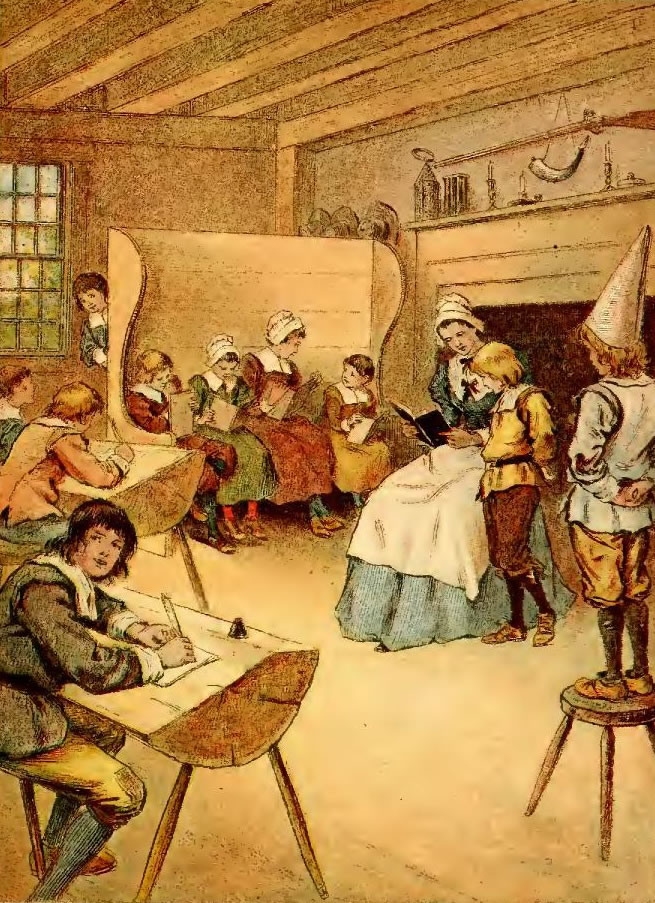 Family-Based Education: Education began in the home. Parents were responsible for teaching their children basic literacy skills, religious texts, and moral values. The family served as the primary educational institution.
Family-Based Education: Education began in the home. Parents were responsible for teaching their children basic literacy skills, religious texts, and moral values. The family served as the primary educational institution. Hornbooks and Primers: Puritan children typically started their education with hornbooks and primers. A hornbook was a wooden paddle with a printed sheet of the alphabet and religious content covered by a transparent piece of animal horn. Primers were simple books that included religious verses, catechisms, and the alphabet. Grammar Schools: As children grew, they might attend grammar schools, which were the equivalent of elementary schools. Here, they learned basic reading, writing, arithmetic, and religious studies. The New England Primer was a popular textbook in these schools. Moral and Religious Instruction: Moral and religious instruction was a Central focus of education. Children were taught to read and understand the Bible, memorize religious texts, and learn Puritan beliefs. This emphasis on religious education was essential to instill the Puritan faith in the next generation. Limited Curriculum: The curriculum was relatively narrow, with an emphasis on religious texts and basic literacy. The Puritans believed that reading and understanding the Bible was paramount, and other subjects were secondary. community Involvement: Schools were often supported and overseen by the local community. Teachers were highly respected members of the community and played a crucial role in shaping the moral and educational development of children. Limited Opportunities for Girls: Education for girls was more limited compared to boys. While girls received basic literacy and religious instruction at home, they were less likely to attend formal schools. Their education was primarily oriented toward domestic and religious roles. Apprenticeships: After completing grammar school, boys might enter apprenticeships to learn specific trades or crafts, which provided practical skills and training. Higher Education: Some Puritan communities established institutions of higher education, such as Harvard College, primarily to train ministers. These institutions were few, and access was limited. Puritan education aimed to produce literate, religiously devout individuals who could uphold and pass on Puritan values and beliefs. While it had a strong religious foundation, it laid the groundwork for the development of a more comprehensive education system in later American history. |
 | 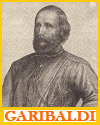 | 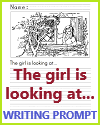 |  | 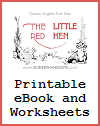 | 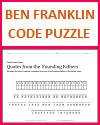 |
| Colonial Period Books and Films | Colonial Period Learning and Study Games |
| Colonial Period Image Galleries | Colonial Period Outlines and PowerPoints |
| Colonial Period Miscellany | Colonial Period Worksheets |
| www.studenthandouts.com ↣ U.S. History ↣ Colonial Period ↣ Maps and Pictures |














































